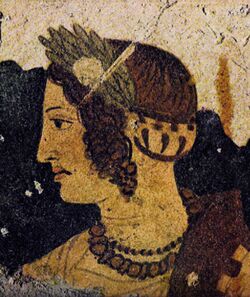Miama of Salidros
This article is non-canonical either because it refers to out-of-character content, the associated nations have left the region, or the information has been retconned. Accordingly, its content should not be considered to be part of the canonical structure of the region's lore.
|
Script error: The module returned a nil value. It is supposed to return an export table.
| Miama I | |
|---|---|
 Mural depicting Miama prior to her "ascension". | |
| Archon of Salidros | |
| Reign | 456 - 447 BC |
| Coronation | 456 |
| Predecessor | Lacros II |
| Successor | Title abolished |
| Born | c. 487 BC |
| Died | Spring of 447 BC Salidros, Kingdom of Salidros |
| Issue | None |
| House | House of Perion |
| Father | Lacros I of Salidros |
| Mother | Seina of Cenei |
Miama (born Ranaria Perion; named Miama posthumously as per Glaistic naming customs, meaning "deceitful"; c. 487-447 BC) was the seventh Archon of Salidros, and the first ethnic Glaistic ruler of the realm. She was also the first recorded female Archon.
Miama came to the throne of Salidros in 447 BC following the death of her twin, Lacros II. Lacros II had become sick with leprosy five years prior, which had prompted him to constantly wear a mask of gold and a cloak over his head to hide his disfigurement. Insecure of his position, he had requested for Miama to be the only contact between him and the rest of the world. This caused Miama to be the only one to find out about his brothers passing, which prompted her to disguise herself as her now-dead brother and continue to rule as him.
Lucros II's wife was forced to divorce him following his contraction of leprosy, so Miama posing as him never married nor had any kids. She adopted the orphaned son of a local noble who was to be the next archon, but the collapse of the Kingdom of Salidros meant he never ascended to the throne.
Reign
Due to the unusual circumstances of the ascension of Miama, her reign is very well documented. Despite this, the exact years of her reign are debated to this day, as Lucros II's date of death is unknown, it's unsure when exactly Miama took the throne.
Generally Miama's reign has been thought to be relatively short, between five and ten years. Dynastic records by Glaistic historians never mention Miama, but this is thought to be due to Glaisto-Istroyan law forbidding women from ruling as archons. Historians and authors from the era wrote extensively on her life and death due to the peculiar nature of it, which places her reign ending in 447 BC, with her identity revealed once the mask was finally removed.
The year that Miama's reign is ended in has been documented well, but due to Miama being the only person in regular contact with Lacros II towards the end of his life, its unsure when she took the identity of her brother. The historian Velza wrote of Lacros II and his sister departing for a temple in the mountains to seek for a cure from the gods in 456 BC and that upon Lacros II's return, he was cured of his illness and that his sister's horse had lost its footing and fallen down the mountain, resulting in her death. Velza's writing is generally thought to be the most reliable source, as Velza worked in Lucros' court.
Accomplishments
Building projects

What Miama is remembered the best for is her vast building projects she commissioned during her short reign. The most well documented of these might be the expansion and reconstruction of the road network in Salidros. Having spent vast periods of time traveling between Salidros and the countryside in her youth, she had personally witnessed the poor state of the roads built by her predecessors in the area. The main roads connecting the larger cities were at best full of holes, at worst nothing more than a dirt path, while the roads that connected smaller towns with larger cities were nonexistent. She first ordered all of the main roads to be inspected and reconstructed before ordering the expansion of the road network to be connected to at least 20 more Salidran towns.
It was commonplace for archons to construct monuments for themselves, a tradition which Miama followed. As Lacros II hadn't had the chance to order a statue of his own, she ordered one to be built for herself instead of Lacros II, claiming it to honour the memory of her now supposedly dead sister. Apparently many smaller monuments were constructed across multiple cities in Salidros, but most of them have not survived to modern day due to the destruction of these statues following the discovery the archon had been a woman posing as the king. Many busts based on these monuments have survived, however, suggesting that despite her unusual rule, she was popular among the people due to busts depicting her seemed to be commonplace.
More well-preserved construction projects ordered by her included the Grand Temple of Salidros, a temple dedicated to Acunia, the Glaistic god of health. The vast amount of wealth and resources required to build the temple would've bankrupted Salidros, so Miama ordered the dismantlement of the Istroyan temple off the coast of Salidros to acquire the resources to build it. Miama based the construction of the temple on the story she had used to explain the miraculous recovery of Lacros following his visit to the mountains. The story of Lacros' miraculous recovery and the construction of the temple sparked a renaissance in the popularity of not only Acunia, but the Glaistic religion in general, as the introduction of the Istroyan pantheon following the establishment of Aciriano-Istroyan Kingdom had quickly reduced the popularity of the domestic religion.
She also was the one to order the construction of the Mausoleum of Salidros in the foothills of the mountains. The construction was halted following her death, but it was eventually restarted around 20 years after her death, and eventually housed the archons of multiple dynasties from around the Glaistic world and an ancient place of pilgrimage.
Preservation of Glaistic culture
Since the establishment of the Glaisto-Istroyan Kingdoms around 150 years prior to her life, a Glaistic archon had not ruled any of the kingdoms. Half and quarter Glaistics were commonplace, but Miama was the first whose both parents were Glaistic, or at least had minimal Istroyan ancestry. Miama actively worked to destroy and remove Istroyan influence and history by destroying Istroyan temples, appointing Glaistic officials over Istroyan and there are even records of her attempting to create a Glaistic script to replace the Istroyan one.
Miama worried for the future of Glaistic culture, which is why she also invested heavily into the documentation of their practices and beliefs. She was the first Salidran leader to also completely abandon the Istroyan pantheon in favour of the Glaistic one and even momentarily criminalized the Glaistos from practising the Istroyan religion.
Reduction of the archons power
Miama also started the efforts of turning the Kingdom of Salidros into a democracy, breaking the traditional northern monarchy/southern democracy which had ruled the land following the collapse of the initial Aciriano-Istroyan kingdom. Her initial efforts included the formation of a senate where nobles chosen by the people gathered to debate on matters that the king had worked on. It's thought that these efforts were another effort by Miama to ensure the stability of the kingdom after she had passed, but the kingdom instead shattered into multiple smaller kingdoms and democracies quickly after her passing.
Purpose of disguising herself
The reason Miama became her brother instead of simply announcing his death has been a topic of debate since her death. Theories such as mental illness and her act being a coping mechanism have been theorised in modern times, while in her time it was thought she was simply hungry for power; following the introduction of catholicism into Aciria she was even theorized to have been possessed by a demon. Most modern scholars however, believe that Miama and her brother did this together in order to try and keep the kingdom together. Lacros II's illness caused him to have little control over his kingdom and his subjects, which in turn made the centralized power of the archon practically nonexistent. At Lacros II's death it was feared the kingdom would fall apart, which is why Miama was tasked with keeping the kingdom together, and it was easy due to the mask and hood which concealed her identity as well as it did her brothers.

Legacy
Despite the initial shock and outrage of the kingdom being ruled by a woman for years, it quickly started discussion in the upper classes of society whether or not women should be allowed to become archons. As the word of the female archon spread across the kingdoms, so did the discussion. Over time, Miama's legacy gave women of her time more power than before, being allowed in ruling positions in monarchies and democracies alike. Many historians attribute her as the figure which shattered the very male-dominated society typical for the time for a society where women were allowed to reach high positions, at least on a judiciary level.